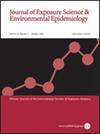孕期接触空气污染混合物与产后心理功能:与种族/人种和胎儿性别有关。
IF 4.7
3区 医学
Q2 ENVIRONMENTAL SCIENCES
Journal of Exposure Science and Environmental Epidemiology
Pub Date : 2024-11-21
DOI:10.1038/s41370-024-00726-2
引用次数: 0
摘要
背景:产前空气污染(AP)暴露与产后心理功能有关,影响妇女和儿童的健康结果。现有研究主要集中在单个污染物上:利用每日暴露数据和数据驱动统计方法,评估产前暴露于七种空气污染成分混合物与产后心理功能之间的关联:分析对象包括 981 名妊娠 24.0 ± 9.9 周的妇女,并对其进行了纵向跟踪。我们利用经过验证的全球三维化学传输模型和基于住址的卫星混合模型,估算了产前每日接触细颗粒物成分[元素碳(EC)、有机碳(OC)、硝酸盐(NO3-)、硫酸盐(SO42-)、铵(NH4+)]、二氧化氮(NO2)和臭氧(O3)的水平。对参与者进行了爱丁堡产后抑郁量表(EPDS)测试,以得出 EPDS 总分以及厌世情绪和抑郁症状的子结构分数。在贝叶斯核机器回归(BKMR)中采用了分布式滞后模型(DLM),以得出每种污染物的时间加权暴露概况。然后将这些暴露量输入加权量子和(WQS)回归,以估计总体混合效应,并根据产妇年龄、教育程度、种族/民族、分娩季节和分娩年份进行调整。此外,还研究了种族/人种和胎儿性别的效应修正:结果:产妇主要为西班牙裔(51%)和黑人(32%),受教育年限低于 12 年者占 58%。产前接触 AP 混合物与失乐症分量表 z 评分的增加有显著相关性,尤其是在西班牙裔妇女中(β = 0.07,95%CI = 0.004-0.13,WQS 指数每增加一个单位)。它还与 EPDS 总分(β = 0.11,95%CI = 0.00-0.22)和抑郁症状分量表(β = 0.09,95%CI = -0.02 至 0.19)z-分数的增加有边缘相关性,尤其是在生了男婴的西班牙裔妇女中。硫酸盐(SO42-)、O3 和 OC 是造成这些关联的主要因素:本研究采用先进的数据驱动方法,研究了产前空气污染暴露对产后心理功能的时间和混合加权影响。我们发现,暴露于产前空气污染混合物会导致西语裔女性产后心理功能较差,尤其是失乐症状。研究结果强调了同时考虑暴露混合物和潜在调节因素的重要性,以更好地帮助确定产生影响的特定污染物和易感人群,从而为更有效的干预策略提供依据。本文章由计算机程序翻译,如有差异,请以英文原文为准。

Air pollution mixture exposure during pregnancy and postpartum psychological functioning: racial/ethnic- and fetal sex-specific associations
Prenatal air pollution (AP) exposure has been linked to postpartum psychological functioning, impacting health outcomes in both women and children. Extant studies primarily focused on individual pollutants. To assess the association between prenatal exposure to a mixture of seven AP components and postpartum psychological functioning using daily exposure data and data-driven statistical methods. Analyses included 981 women recruited at 24.0 ± 9.9 weeks gestation and followed longitudinally. We estimated prenatal daily exposure levels for constituents of fine particles [elemental carbon (EC), organic carbon (OC), nitrate (NO3−), sulfate (SO42−), ammonium (NH4+)], nitrogen dioxide (NO2), and ozone (O3) using validated global 3-D chemical-transport models and satellite-based hybrid models based on residential addresses. Edinburgh Postnatal Depression Scale (EPDS) was administered to participants to derive a total EPDS score and the subconstruct scores for anhedonia and depressive symptoms. A distributed lag model (DLM) was employed within Bayesian Kernel Machine Regression (BKMR) to develop time-weighted exposure profile for each pollutant. These exposures were then input into a Weighted Quantile Sum (WQS) regression to estimate an overall mixture effect, adjusted for maternal age, education, race/ethnicity, season of delivery, and delivery year. Effect modification by race/ethnicity and fetal sex was also examined. Women were primarily Hispanic (51%) and Black (32%) reporting ≤12 years of education (58%). Prenatal exposure to an AP mixture was significantly associated with increased anhedonia subscale z-scores, particularly in Hispanics (β = 0.07, 95%CI = 0.004–0.13, per unit increase in WQS index). It was also borderline associated with increased total EPDS (β = 0.11, 95%CI = 0.00–0.22) and depressive symptom subscale (β = 0.09, 95%CI = −0.02 to 0.19) z-scores, particularly among Hispanic women who gave birth to a male infant. Sulfate (SO42−), O3 and OC were major contributors to these associations.
求助全文
通过发布文献求助,成功后即可免费获取论文全文。
去求助
来源期刊
CiteScore
8.90
自引率
6.70%
发文量
93
审稿时长
3 months
期刊介绍:
Journal of Exposure Science and Environmental Epidemiology (JESEE) aims to be the premier and authoritative source of information on advances in exposure science for professionals in a wide range of environmental and public health disciplines.
JESEE publishes original peer-reviewed research presenting significant advances in exposure science and exposure analysis, including development and application of the latest technologies for measuring exposures, and innovative computational approaches for translating novel data streams to characterize and predict exposures. The types of papers published in the research section of JESEE are original research articles, translation studies, and correspondence. Reported results should further understanding of the relationship between environmental exposure and human health, describe evaluated novel exposure science tools, or demonstrate potential of exposure science to enable decisions and actions that promote and protect human health.

 求助内容:
求助内容: 应助结果提醒方式:
应助结果提醒方式:


